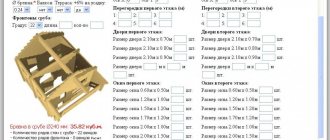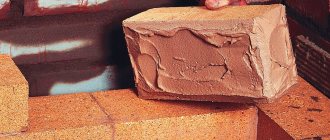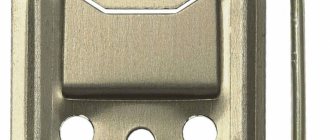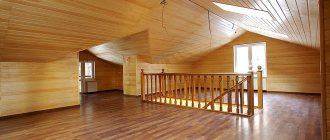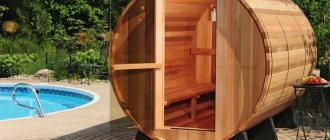Lining is a universal material, used mainly for interior work. The cost of this building material varies depending on its quality. Before you begin installing the lining, you should make the necessary calculations of its quantity, for which you can use an online calculator, or know how to calculate the lining yourself.
A convenient and simple calculator for calculating the amount of lining: https://otdelkaexp.ru/kalkulyatory-rascheta/kalkulyator-rascheta-vagonki-dlya-sten-po-ploshhadi.html.
We calculate the lining per m2
If it is not possible to use an online calculator, then you should use basic knowledge of geometry and spend a little time. For example, we use a standard room with the following dimensions:
- Length – 8 m.
- Width – 5 m.
- Height – 2.35 m.
The sequence for calculating the amount of wood paneling is as follows:
- Find out the area of all the walls in the room. First, you should calculate the longest wall and multiply by 2. To do this: 8 m must be multiplied by 2.35 m and multiplied by 2. Answer: 37.6 m2 is the total area of \u200b\u200bthe two walls.
- Next, we find the area of the smaller walls: multiply 5 m by 2.35 m and multiply by 2. Answer: 23.5 m2.
- The total area of the walls of the room will be: 37.6 m2 plus 23.5 m2. Answer: 61.1 m2. But we should not forget about such an important parameter as the surface area of the ceiling, which is equal to the area of the floor. Calculation: multiply 8 m by 5 m, answer – 40 m2. This means that the total area that needs to be covered with clapboard will be 101.1 m2.
Video on Youtube:
For greater accuracy, you should make a small margin, for example, a couple of square meters on top. And the final answer will be 103-105 m2. This amount of wood paneling is quite enough to cover a room with the above parameters.
Of course, the data obtained is quite enough to purchase the required amount of lining. But the lining is sold in the form of separate boards, with certain dimensions, and a situation may arise when a hardware store needs to name the exact number of these same strips, and not the total square footage. To calculate the number of lining strips, you should find out the size of one, which is 6 m by 0.15 m. The standard thickness of one board is 2.5 cm, but this parameter is most often not used, because the area is calculated, not the volume.
The surface area of one board is 0.9 m2. It remains only 105 m2 divided by 0.9 m2, which will be equal to 117 (rounding up 116.6) pieces of wood paneling.
What units are the lining sold in?
Lining is mainly sold by cubic meters, which can create some inconvenience when calculating the required amount of material. For greater convenience, it is worth remembering approximately how much area a lining of a certain size can cover:
- a panel whose dimensions are 6000*200*8 mm will occupy an area of 1.2 m2;
- if the lining parameters are 6000*250*5, then the area size will be 1.5 m2;
- a panel with dimensions 2600*148*6 will cover an area of 7.07 m2.
As you can see, the dimensions of the material take into account the thickness indicator. If the lining is sold individually, then the thickness indicator has no meaning and is not used when performing the calculation.
However, in the case of selling material in units of volume, the thickness parameter has a significant impact on the final result when calculating the required amount of lining.
Calculation of lining for the attic
For such a room in a house as an attic, you should use a fairly simple and practical formula:
S = 2AB + 2b (4A2-b2)/4
The components of this formula are as follows:
- S – total area.
- A is not the total length of the room, but the distance from the ridge to the beginning of the roof slope.
- B is the width of the room.
- b – door width.
Calculation of lining for the attic
But we should not forget that the attic can be built with additional bulkheads, the parameters of which should also be included in the formula:
S = 2AB + 2b (4A2-b2)/4 + Ph
This formula is practically no different from the previous one, with the exception of two components:
- P is the perimeter of the bulkheads, which can be found by multiplying the width by the length of the bulkhead.
- h is the height of the bulkhead.
Accurate calculator for calculating lining: https://bouw.ru/calculator/raschet-vagonki.
How many square meters are there in a pack of imitation timber?
Table of area and volume of lumber
| Products | In 1 package M 2 | M2 to 1m3 |
| Imitation timber 18x145x6000 (5 pcs) | 4,11 | 52,5 |
| Imitation timber 21x145x6000 (4 pcs) | 3,28 | 44,9 |
| Imitation timber 21x195x6000 (4 pcs) | 4,53 | 46 |
| The board is strict. 21x96x3000 (6 pcs) | 1,73 | 47,68 |
We calculate the amount of lining for the balcony
Calculating the material for the lining is practically no different from calculating a standard room, with the exception that the area of the balcony should be divided into separate components, which will greatly simplify the process. For example, a balcony consists of a space under a window facing outside (length - 4 m, height - 1 m), a ceiling (length - 4 m, width - 2 m), a lower part on the side of the balcony door (length - 3.6 m, height - 1 m) and two side walls (length – 2 m, height – 2.5 m). We carry out calculations separately:
- The sheathing area of the space under the window facing outside: 4 m multiplied by 1 m, the answer is 4 m2.
- Ceiling area: 4 m multiplied by 2 m, answer – 8 m2.
- The area of the lower part on the side of the balcony door: 3.6 m multiplied by 1 m, the answer is 3.6 m2.
- Sheathing area of two side walls: 2 m multiplied by 2.5 m and by 2, answer – 10 m2.
- All that remains is to add up the resulting numbers: 4 m2 plus 8 m2, plus 3.6 m2 and plus 10 m2, the answer is 25.6 m2.
Accurate calculation of lining for a balcony
We round the result up and add a couple of meters of material for unforeseen expenses. The final answer: covering a balcony with clapboard will require 28 m2 of building material. As stated earlier, the area of one board is 0.9 m2. 28 m2 must be divided by 0.9 m2, which will be equal to 32 (rounding up 31.1) pieces of lining.
Calculation for using the material outside the building
In this case, calculations are carried out according to the same principle. The only caveat: much fewer surfaces will be taken into account. And if you do everything yourself, then difficulties may arise at the stage of determining the area of the pediment.
So, you need to determine the area of the walls, having previously known the height and length of each. That is, the procedure is similar. To determine the area of the gables, multiply the height by the length of the base and then divide by two.
After this, the resulting figures need to be summed up and then subtracted from the area of the openings.
Recommendation: since the installation is carried out according to the tongue-and-groove principle, the value of the useful width of the lining should be used in calculations.
Useful numbers - why do you need to know the volume of the lining?
This is a universal number that is unchanging. From it you can make any calculations: prices, number of lamellas, total delivery cost, etc. You cannot sell lining by weight - wood tends to accumulate moisture. The calculation of the board in volume is free from almost all disadvantages. The product passport must indicate the volume of the purchased material, its number, dimensions, degree of humidity, and a number of other indicators that will regulate further work with the material.
To perform high-quality repairs, you need to know not only the volume of wood, but also the proportions of the board. Purchasing a sufficient amount of consumables will speed up the work and save on delivery. When completely impregnating a solid material with protective agents, it is better to focus not on the footage, but on the total volume.
This is why it is important to know how much lining there is in a cube.
Types of wood
The quality of the lumber and, as a consequence, the final appearance of the product, significantly affects the price of the lining.
There are four main types of wood that can affect the cost:
It is not difficult to calculate the required amount of material. If any difficulties arise, the seller of the product will always come to the rescue. The main thing is to make all calculations on time, before the transaction is completed. This will help save money and prevent a situation where a very large amount of trim remains after repairs.
Of course, there should be a supply of lining, but within reasonable limits. As a rule, experts recommend adding 10-15% of the reserve to the calculated value of the required amount of material.
Calculation of lining - tricks for saving
For a room with smooth walls of the same size, it is better to calculate the volume of the lining, based on the fact that the length of the lamella is equal to the height of the wall. This way you can save as much as possible on large orders. To calculate the required volume, you need to use the formulas given above.
However, for even greater savings, you can order two types of lining separately. They should differ only in length. The width, thickness, and type of lock must be the same for durable installation and beautiful design.
For those parts of the walls where there are no windows, doors, ledges, etc. A standard lining is purchased, with a length equal to the height of the wall. For those parts of the wall where the board will have to be cut, materials are purchased separately. As a rule, priority is given to production waste - lamellas approximately 1 meter long are sold in the warehouse for a third the price. Such a product is much cheaper than standard boards, but has the same class and does not have defects or visual flaws. Such a purchase will save an extra thousand rubles. Calculating the square footage will not be a big problem - you just need to divide the walls into small squares, calculate their parameters and area separately.
What is affected by the volume of building materials?
Before calculating the lining, I’ll say a few words about why it’s important to determine everything as accurately as possible.
The volume of material affects a number of factors:
- cost of wooden products;
- delivery price;
- necessary paint and varnish materials;
- number of consumables and fasteners.
The price of lumber depends on several points, including the type of wood, its grade, raw materials for production, and overall dimensions.
If you calculate the total required volume of material, you can determine the total cost and your purchasing costs.
Application of calculation to calculate the costs of room cladding
If you need to find out the costs with a known cladding area and the price of a cube of lining, you should recalculate how many square meters are in a cube of lining.
To do this, you can use an online area calculator or perform the calculation manually.
The same profile provides coverage area
0.096 x 3 = 0.288 sq.m. Consequently, 277 (rounded down) strips that fit in 1 cube of lining have a total area
0.288 x 277 = 79.776 sq.m.
If only 25 square meters are needed for cladding, then the number of lamellas will be
25: 0.288 = 86.7 pieces
And they will take up volume
86.7 x 0.0036 = 0.3125 cubic meters.
At a price of lining per cubic meter of 16,000 rubles, the required quantity will cost
16,000 x 0.3125 = 5,000 rubles.
Volume/Humidity Relationship
The price of lumber delivery directly depends on its weight, and therefore on humidity. Wood tends to accumulate and release moisture quite quickly. For a large order, an increase in wood moisture content by 3-4% means an increase in delivery costs by several thousand.
To avoid being deceived, recalculate the amount of lining and its weight relative to the standards. So, for wood that is stored in a warehouse, the permissible humidity is about 12%. Weighing of lumber occurs immediately before shipment, however, if the conditions in the warehouse do not meet the standards, then the humidity will rise, and with it the price for delivery. You can prevent yourself from being deceived by recalculating the weight of the required volume of materials relative to its standard weight. Tables with exact data on the weight of 1m3 of any wood can be found freely available on our website.
1 m3 of finished oak board weighs 700 kilograms. If the seller requires the buyer to pay the cost of transportation of one ton, and not the declared 700 kg, it means that the wood has too much moisture or is damaged. By overpaying an unscrupulous seller, you can not only increase the cost of repairs, but also receive defective goods, especially if the order arrived at the construction site from afar.
Simple formula
To find out how much wooden lining there is in 1 m3, use a simple formula:
1/(lamella width*thickness*length). The resulting result is rounded to 1 unit (always upward).
Example for a wooden board with dimensions 150x25x2000 mm:
1/(0.15x0.025x2)=1/0.0072=133.3 = 134 pcs.
Similar calculations can be made with different types of lamellas to determine the exact amount of finishing material and calculate its approximate cost. So, knowing the price per m3, you can find out the price of one board:
Price per m3/number of boards.
Example for a board of the same dimensions:
6000 rub./134pcs.=44.7 rub. per piece (approximate price).
What's the best way to calculate?
When finalizing the design of your bathhouse building from the point of view of determining the material consumption of interior decoration, you can rely on a simplified calculation method (by area) or approach the solution of the problem in more depth, and also choose some intermediate approach. The operation of most relevant online services is based on the simplified calculation algorithm, or preliminary quick estimates are made manually. This method gives an understanding of the required approximate budget to bring the building to a residential condition. Calculating the lining by area allows you not to delve into the intricacies of the problem, which will save you time, but purchases based on it will require additional expenditure on the supply of boards for trimming.
Simplified area calculation
It is based on simple geometric calculations based on the dimensional parameters of the premises, without taking into account the installation features and standard sizes of lumber. Diagram 1 shows the building plan, indicating the internal dimensions of the box premises. It is these dimensions, and not the final ones, that are often included in the simplified calculation of bathhouse lining.
And so, we have three interior rooms with wall perimeters:
Summing up the obtained values, we obtain the total perimeter:
Using the height parameter, we find the area of the walls:
Scheme 1
It won’t be difficult to find the total area of all ceilings, which are also usually covered with clapboard:
Then all you need for the ceiling are:
In total, for the interior lining of the bath you will need:
82,225+24,84=107.065 m2 .
How best to use the results obtained?
Armed with the results obtained, you can now head to the retail outlet to find out how much the lining for a bathhouse costs, and select the material you like. However, if you make purchases based on the obtained figures, then this will not be the most economical approach, as will be shown below.
However, there is a little trick: if you buy wall boards no longer than 2.45 m and place them vertically, the amount of trim will be minimal. Why 2.45 m and not 2.5 m? The minimum reserve for ventilation gaps is taken into account here. Issues of ventilation of decorative coverings, as well as the disadvantages and advantages of vertical or horizontal arrangement of panels are described in detail here. Such a reduction in the lengths of the boards, in principle, can be taken into account from the very beginning when calculating the amount of lining by area.
In addition, check the regularity of deliveries to the retail outlet of the products you are interested in, this will allow you to slightly reduce the volume of the initial order. Then, having already completed finishing activities, you will be able to additionally order lumber of the required type, taking into account the actual adjustment of its quantity. The downside, of course, will be additional transportation costs.
Online calculator
To calculate the cost of a cube of lining and obtain data on the number of pieces in the specified volume, the following data in meters or millimeters is required:
- lamella length;
- width;
- thickness.
The calculation formula is extremely simple: the volume of one lamella is calculated and then it is determined exactly how many of them are required to fill a cubic meter of space.
As an example, let’s calculate how much eurolining is in a cube for a “Standard” profile with a length of 3 meters.
For calculations, we take the total volume of the lining according to overall dimensions - 96x12.5x3000 mm. To simplify the task, we convert the dimensions to meters.
0.096 x 0.0125 x 3 = 0.0036 cubic meters. Thus, in one cube of lining there will be
1: 0.0036 = 277.8 pieces.
How to calculate the area of the first floor
It is better to consider the algorithm for calculating the area of a room using the example of a 5x8 house, where we will cover the walls and ceiling with clapboard.
Next you need to calculate the square footage of one of the rooms. Let its length (a) be 5m, width (b) 4m, and height (c) 2.5m. And then everything was as we were taught in the school geometry course.
- Let's start with a long wall: multiply its height by length (ac) = 5x2.5 = 12.5 m2.
- The opposite wall will be the same size, so we simply multiply the result by two. 12.5x2=25 sq. m.
- Now, using the same principle, we find the size of the smaller wall (bc) = 4x2.5 = 10 square meters. Multiply by two. 10x2=20 sq. m.
- We multiply the length of the room by its width and get the ceiling area (ab) = 5x4 = 20 square meters.
- Let's summarize the data obtained from points 2, 3 and 4. And in addition, the square footage for finishing one room is 25 + 20 + 20 = 65 square meters.
Using the same principle, we find the parameters of the remaining rooms and summarize. In this case, the second room had the same dimensions, so the area of the entire first floor is: 65+65=130 square meters.
Wood selection
Today, the construction market is filled with a variety of options for finishing materials, so for a beginner in repair and construction, choosing lining can be a serious challenge.
The main thing that a buyer must go to the market with is the concept of the exact value of the required amount of material. This approach will help prevent some uncomfortable situations. After all, buying extra materials leads not only to a loss of money, but also time for its possible return.
Let's look at the types of trees most commonly used in lining production:
